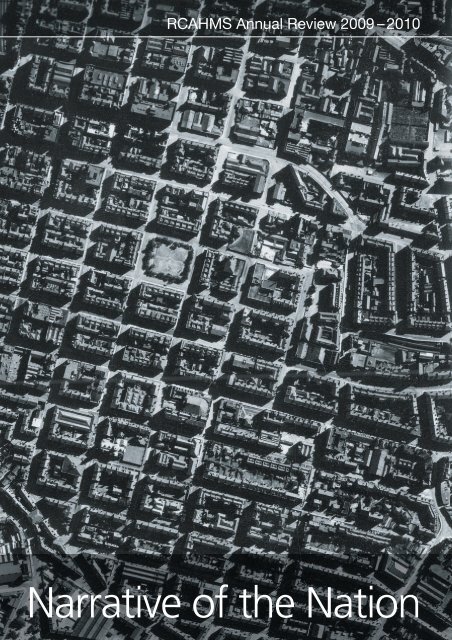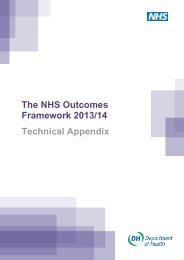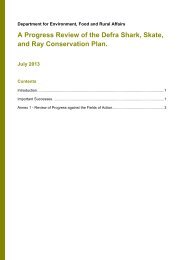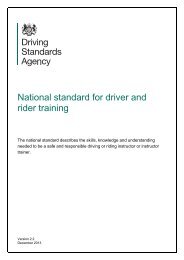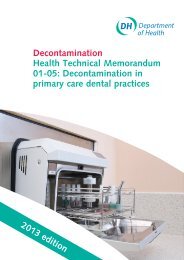RCAHMS Annual Review 2009-2010
RCAHMS Annual Review 2009-2010
RCAHMS Annual Review 2009-2010
- No tags were found...
Create successful ePaper yourself
Turn your PDF publications into a flip-book with our unique Google optimized e-Paper software.
ContentsNarrative of the Nation 3Showcasing the National Collection 5Scran’s Commitment to Excellence 7The National Collection of AerialPhotography Goes Global 9Rare Additions to Historical Archives 9Surveying at the End of the World 10Inspiring Communities to Record Scotland 11Everyone’s National Collection 13Scotland’s History on the Digital Map 15Orders in One Click 17Corporate Affairs and Finance 18Commissioners 201
2Visitor records brokenBook sales quadrupledMillions of new website users
Narrative ofthe NationChairman, Professor John Hume and Secretary, Diana MurrayFor over 100 years <strong>RCAHMS</strong> has worked to deliver for the people of the nation a knowledgehub that records, interprets and promotes the built heritage, and that contributes to thegrowth of a successful Scotland. As we move from the celebrations of our centenary into thechallenges of our next century, we are striving – both independently and in partnerships – tocreate a narrative of the nation that is valued both by our own people and by other countriesacross the globe.Through <strong>RCAHMS</strong> unique holdings, we play a key role in defining Scotland’s national andcultural identity, connecting people to places across time. The diverse work we carry out isessential to developing our sense of history and identity, and encourages people to value andenjoy their built environment: both key outcomes of the National Performance Framework.Our National Collection is here for our professional users, the many archaeologists andarchitects who pore over our wealth of photographs, drawings and manuscripts. We are onhand to guide future generations, inspiring learning in school children and students throughuniquely packaged educational resources. Our expert staff train local communities, allowingthem to record and interpret the abandoned remains of rural Scotland. On foot and in the airour survey teams add new chapters to the story of the nation, documenting our heritage inever greater detail and making discoveries that change our understanding of history.Our knowledge hub is a modern, easily accessible resource which provides an underpinning,reliable service from which others in the sector can capture efficiencies and reap economicbenefits.In <strong>2009</strong> –10, more than ever before, <strong>RCAHMS</strong> has reached out to all of its constituents. InAugust <strong>2009</strong>, our online archive Canmore opened its virtual doors to public contributions,inspiring an army of amateur archaeologists and surveyors to share their high qualityphotographs and information. Just two months later, we launched the ScotlandsPlaceswebsite in partnership with the National Archives of Scotland, creating a map-based historicaldatabase that allows other archives to come on board and share their materials in one place.In a bestselling publication, we packaged over 90 years of aerial photography from ourcollections for the mass-market, telling the story of the nation from pre-history to the presentday from a unique perspective. And, in November <strong>2009</strong>, the launch of a website featuringworldwide aerial photography brought the eyes of the global media to <strong>RCAHMS</strong>, as ourinternational collection of wartime photographs was beamed from continent to continent.<strong>RCAHMS</strong> is a dynamic knowledge hub. Our dedicated, expert and highly skilled staff bring itto life, but so, crucially, do all of our professional and community users. History, heritage andstories come together in a constantly expanding archive. As a body of Scottish and worldwideknowledge of the built environment, <strong>RCAHMS</strong> grows increasingly valued and valuable.<strong>RCAHMS</strong> is for everyone.3
5,000 bookssell out innine weeks4
Inspire learningand intellectualcuriosity in ournational cultureand identityat home andworldwide.1Showcasing the National Collection1In <strong>2009</strong> –10 <strong>RCAHMS</strong> broke new ground in promoting public access and engagement with1its unique archive holdings.1At the forefront of a new publications strategy, two major books – produced to the highest1standards of content and design – were conceived with the express aim of reaching the1widest audiences possible and increasing understanding of the <strong>RCAHMS</strong> National Collection. 1In Above Scotland, the finest images from the National Collection of Aerial PhotographyIn Above Scotland, the finest images from the National Collection of Aerial Photographywere used to tell the history of the nation – from earliest times to the present day – from aunique and illuminating perspective. Selected as the prestigious Waterstone’s Scottish Bookof the Month for November <strong>2009</strong>, it sold out its first print run of 5,000 hardback copies innine weeks, making it a UK bestseller in Art, Architecture and Photography.Wanderings with a Camera in Scotlandwas published to coincide with the launch of an<strong>RCAHMS</strong> touring exhibition, which opened at the Taigh Chearsabhagh Museum and ArtsCentre in North Uist. Showcasing a rare collection of nineteenth and early twentieth centuryglass plate negatives taken by amateur photographer Erskine Beveridge, it was selected asa Scotsman ‘Book of the Year’ by Scotland’s Education Minister Michael Russell.As high-end, Scottish-themed photographic books, the two titles accounted for 85 percent of <strong>RCAHMS</strong> highest ever yearly publication sales – which were almost quadruplethe previous year’s figures. This new approach of embracing mass-market publishingopened up nationwide publicity opportunities to boost the profile of <strong>RCAHMS</strong> inways that transcended pure units sold. A media partnership withThe Scotsmanand Scotland on Sundaysaw 210,000 32-page supplements themed around thebooks being distributed with weekend newspapers in June and October <strong>2009</strong>,and promoted by free print, radio and TV advertising.The breadth of the <strong>RCAHMS</strong> historical photographic collections was alsoshowcased in a series of five supplements – with the theme ‘Old Scotland’– running over consecutive days inThe Scotsman and Scotland on Sundayin March <strong>2010</strong>. Supported by free, prime-time advertising on ScottishTelevision, in total 220,000 supplements were printed and distributed.Each supplement covered a different geographical area of Scotlandand featured introductions by <strong>RCAHMS</strong> senior management.5
6Scran’seducationalresourcesused byevery localauthorityschool inScotland
Inspire learningand intellectualcuriosity in ournational cultureand identityat home andworldwide.Scran’s Commitment to ExcellenceFrom August <strong>2010</strong>, primary and secondary schools throughout Scotland have begunworking within a radical new curriculum framework. Known as the ‘Curriculum forExcellence’, the Scottish Government initiative has been designed to evolve the ways inwhich teaching and learning take place – opening up more flexible ways of tackling subjects,encouraging work across subject boundaries and recognising the wide range of experiencesbeyond the classroom which can enhance pupils’ knowledge and understanding.Throughout <strong>2009</strong> –10, Scran – the <strong>RCAHMS</strong> award winning learning website – hasbeen reviewed and adapted to directly meet the aims and requirements of theCurriculum for Excellence. Scran’s resource base gives instant, searchable accessto 360,000 rights-cleared images, videos and audio from museums, galleries,archives and the media, with material ranging from the works of Degasand Dali to diagrams of integrated circuits and adrenal glands. Used byover 3,000 schools across the UK – including every local authority schoolin Scotland – the website supports teachers and learners of all agegroups and stages.The new development in the presentation of Scran resources allowsusers to browse Curriculum for Excellence material from general subjectheadings right down to individual items. Over 2,500 of the site’s existing‘Pathfinder’ packs – specially compiled collections of Scran records thatillustrate particular subject areas – have been adapted for the curriculumand 400 new topics have been identified for development. While manyof these can be created by using existing content, work has also begun onsourcing new material from external organisations as diverse as the ScottishParliament and NASA.The Scran education team have continued to deliver free training sessions in using Scranresources across the whole of Scotland, and these have been reviewed and redevelopedto foreground the opportunities that the site offers to both teachers and pupils withinthe Curriculum for Excellence. With online technologies for communicating andsharing information at the heart of the new curriculum, work over the year hasbeen designed to ensure that Scran remains at the cutting edge of onlineeducational service provision.Questionably Mary Queen of Scots’ ring – Darnley’s unattributed portrait – A detail of an engravingshowing Mary Queen of Scots by Dumbarton c1565 – A fifteenth century gold brooch – A highland dirk,watercolour by James Drummond c1865.Ring and brooch ©Victoria & Albert Museum. Main portrait ©National Galleries of Scotland. Engraving©Hulton Getty. Dirk ©Gaidheil Alba / National Museums of Scotland. Licensor www.scran.ac.uk7
816 million hits onwebsite launch day
Continue to updateour National Collectionthrough field investigation,research and selectivecollecting, and make<strong>RCAHMS</strong> the first port ofcall for information aboutScotland’s places.2The National Collection of Aerial Photography Goes GlobalLaunched in November <strong>2009</strong>, the website of the <strong>RCAHMS</strong> National Collection of AerialPhotography (NCAP) reached a worldwide audience of hundreds of millions.With remarkable, never-before-seen and newly digitised historical images from the archivemade available for the first time – from photographs of prisoners in the central courtyard ofColditz high security prison to prisoners of war working on the infamous bridge over the RiverKwai and images taken during the post D-Day battle for Normandy – the website receivedmassive international media interest.The new photographs were discovered as part of a painstaking process of cataloguing anddigitising imagery from The Aerial Reconnaissance Archives (TARA) for the NCAP website.One of the world’s largest and most important historical aerial photographic collections, TARAwas transferred to <strong>RCAHMS</strong> in 2008 and is made up of tens of millions of aerial intelligencephotographs dating from the Second World War onwards. For such an internationallysignificant archive to be held in Scotland represents a remarkable coup, and continuedinvestigation of its contents has the potential to dramatically change our understanding ofworld history.On the day of the website launch, interviews on BBC Radio 4’s Today programme and GoodMorning Scotland, print and online articles in all major UK national newspapers, and filmfeatures on the BBC Ten O’Clock News and ITN News at Ten, saw NCAP pick up blanket mediacoverage in Britain.Global interest included Spain’s main evening news programme, the Canadian BroadcastingCompany’s evening news, ABC news in America and the website of El Mundo, Spain’s leadingnational daily newspaper – officially the world’s most read Spanish news website, with regulardaily reader figures of over 45 million people. Over 40 countries covered the story ranging fromFrance, the Netherlands, Germany, Poland, Russia and Italy to Argentina, Brazil, India, Israel,China and South Korea.Rare Additions to Historical ArchivesAmong the 134,000 new items acquired by <strong>RCAHMS</strong> in <strong>2009</strong> –10, there were two particularlysignificant additions to our historical collections. In December <strong>2009</strong>, <strong>RCAHMS</strong> took chargeof an archive of photographs and drawings dating from the 1890s to the 1980s relating tothe Edinburgh cabinet makers Whytock & Reid. Founded in 1807, the firm received its firstRoyal Warrant from Queen Victoria in 1838 and would go on to receive international renownfor its upholstery, decoration and quality cabinet making. Supplementing a collection of over20,000 items relating to Whytock & Reid already held by <strong>RCAHMS</strong>, the new material includesdesigns and drawings for furniture ranging from beds to boardroom tables produced for clientsincluding the Royal Bank of Scotland, the Scottish Life Association and St George’s School.Following on from this high-profile acquisition, in March <strong>2010</strong> <strong>RCAHMS</strong> purchased twopreviously unknown perspective drawings by David Bryce, one of the foremost Scottisharchitects of the mid nineteenth century. The two unexecuted designs for the Free St George’sChurch in Shandwick Place, Edinburgh, date from around 1865. Bryce died during constructionand the project was taken over by Sir Robert Rowand Anderson. The rare drawings – whichwere acquired through a grant from the Art Fund – form part of only a small amount of Bryce’swork accessible in the public domain.Caen, Lower Normandy, France, 2 October 1944. 006-001-014-006-C9
Continue to updateour National Collectionthrough field investigation,research and selectivecollecting, and make<strong>RCAHMS</strong> the first port ofcall for information aboutScotland’s places.Inspiring Communities to Record ScotlandIn <strong>2009</strong> –10, the Scotland’s Rural Past (SRP) project continued to inspire local communitygroups in celebrating their national culture and recording historic settlements andlandscapes. Started in 2006 – and shortlisted for Best Project at the 2008 BritishArchaeological Awards – SRP has made a huge contribution to community archaeologythroughout Scotland, developing confidence among local groups to survey their ruralenvironments into the future. In March <strong>2010</strong>, the High Morlaggan project – which involvedSRP volunteers investigating a deserted township on the shores of Loch Long – won theRobert Kiln Trust Award at the Archaeology <strong>2010</strong> Conference held at the British Museum. Aprestigious annual prize given ‘for the best project carried out in the UK by a voluntary bodyor individual’, it further demonstrates the impact of SRP in enabling the public to interactdirectly with Scotland’s built heritage. The evaluation of SRP’s <strong>2009</strong> <strong>Annual</strong> Conferencehighlighted the strong grassroots desire for SRP to continue in some form beyond the projectend date of 2011, and stressed that future success is dependent on maintaining links withlocal communities and offering them the opportunity to contribute their valuable findingsto the National Collection. The work of SRP is possible thanks to support from the HeritageLottery Fund (HLF), the National Trust for Scotland, Historic Scotland, and Highlands andIslands Enterprise.Local volunteers also played a key role working alongside <strong>RCAHMS</strong> survey teams on theIsle of Bute, directly assisting in the location and identification of 185 previously unrecordedarchaeological sites. The discoveries came as part of a three-year, HLF-funded partnershipproject to complete the most detailed ever survey of the island. Working with the DiscoverBute Landscape Partnership Scheme (DBLPS), <strong>RCAHMS</strong> recorded over 600 known and newarchaeological sites. Bute’s local history society and local volunteers have been instrumental inthe success of the project and have received training in archaeological recording techniques,giving them the skills required to follow on the work initiated by <strong>RCAHMS</strong> and DBPLS.the best project in the UK11
Widen digital access toinformation on Scotland’splaces, making it moreinteractive and an integralpart of the burgeoningworld-wide network ofcultural heritage data.3Everyone’s National CollectionFor the first time the public can share their own information and images on the onlinedatabase of Scotland’s National Collection of buildings, archaeology and industry.A window on Scotland’s places, the <strong>RCAHMS</strong> Canmore database features photographs,maps, drawings and expert information on more than 300,000 sites of interest,from abandoned settlements to the local high street, and from ancient stone circlesto historic castles and houses. The pioneering Web 2.0 development of Canmorewas launched in August <strong>2009</strong>, opening up the National Collection to everybody tocontribute their knowledge and upload copies of their own site photographs to be seenby other users.Although Canmore already contains a wealth of information on Scotland’s builtheritage, by actively seeking user contributions, the initiative – which was supportedby the Heritage Lottery Fund – represents a sea change in how the public can interactwith archives. The determination of <strong>RCAHMS</strong> to be as accessible as possible led to areassessment of the boundaries between collections and their audiences, placing a newvalue on the information, stories and reminiscences of every individual – helping toconnect people to places in the digital world.In its first six months, over 1,000 photographs were uploaded and over 200 textcontributions were added to the site, with the public imagery and information having asubstantial impact on the richness and dynamic nature of the database. From kite aerialphotography of remote landscapes and shots of abandoned industrial landmarks, todetailed archaeological and architectural research text, the Canmore development hasrevealed a vibrant online community, by turns curious and knowledgeable about thenation’s built heritage.web 2.0 generates1,000 image uploads13
14two national collectionsworking in closepartnership
Widen digital access toinformation on Scotland’splaces, making it moreinteractive and an integralpart of the burgeoningworld-wide network ofcultural heritage data.Scotland’s History on the Digital MapLaunched in October <strong>2009</strong>, ScotlandsPlaces brings together valuable records from two of thenation’s most comprehensive historical archives in a place-based online search facility.A joint partnership between <strong>RCAHMS</strong> and National Archives of Scotland (NAS), the innovativenew website uses geo-mapping software developed by the University of Edinburgh. Createdwith the principal aim of making information as accessible as possible to the widest audiences,ScotlandsPlaces also uses ‘open source’ mapping technology to allow the web developmentsto be shared with any archives and museums with an interest in digital public access.The website works as a twenty-first century gazetteer, enabling users to search Scottish placenames, counties or parishes and drill down through a selection of map layers – includingOrdnance Survey maps – to refine their search area. Once located, areas can be plotted ongeobrowsers like Google Earth, with relevant archive information pinpointed on the map andable to be studied in greater detail with one click. NAS information includes plans, official landownership documents, medical officer of health reports and tax rolls – which in turn can bestudied in fine detail – while <strong>RCAHMS</strong> information includes place descriptions; photographs,plans and drawings of buildings and landmarks; and associated materials and archaeologicalinformation. By drawing on live data, ScotlandsPlaces allows new information added to thedigitised collections of <strong>RCAHMS</strong> and the NAS to become instantly accessible. Most importantlythe website has been designed to allow the easy integration of additional place-relatedinformation as more partners come on board.Speaking at the website’s launch at the Scotland’s Global Impact Conference at Eden Courtin Inverness, then Culture Minister Michael Russell said, “This innovative website draws on awealth of information from two of Scotland’s national collections, showcasing the benefitsof our public bodies working in close partnership. The site already hosts a vast range ofinformation but it is just the start and I encourage other organisations from the heritageand archive sectors to join up and share their data. I am sure this unique resource will beappreciated by many as they access our nation’s rich stories of people and places over theyears.”Of considerable value to Scots both at home and abroad, ScotlandsPlaces is a publicresource appealing to anyone with an interest in Scottish geography, history and ancestry,and represents an educational resource of immense scope. In March <strong>2010</strong>, the website wasawarded the prize for ‘most beneficial information service’ at the Association for GeographicInformation annual conference in Glasgow.Land Ownership Commission Records 1872–3, digitised for ScotandsPlaces.gov.uk15
16 Blarmachfoldach and Ben Nevis, Inverness-shire1883. From Wanderingswith a Camera in Scotland: The Photography of Erskine Beveridge. SC746281
Achieve furtherefficiency, effectivenessand sustainability inthe use of governmentresources, and build onour capacity to generatenon-government income.Orders in One ClickIn April <strong>2009</strong>, <strong>RCAHMS</strong> introduced a new online ordering system for images and data,making it easier for users to purchase photographs, maps, plans and drawings from theNational Collection.Customers can now instantly buy any image in the Canmore database, as well aspurchase all other archive items and request that images from the collection be digitisedthrough an online order form.As a result of this crucial innovation, <strong>RCAHMS</strong> image sales increased by nearly a quarterat the end of the financial year <strong>2009</strong> –10 compared with 2008–9 – clearly demonstratingthe effectiveness of the system in opening up access to the wealth of material in thearchives. Prior to the sales system, the majority of orders were invoiced, and 90 per centof order payment was made by cheque. In <strong>2009</strong> –10 over 50 per cent of orders werepaid for ‘up-front’ by credit card online. Delivery of images to customers is now carriedout almost exclusively through direct online downloads, resulting in substantial savingsin both time and in the costs of CDs and postage.A key aspect of this new development is capturing user data to inform sales evaluationsand improve efficiency, with all activity from sales now automatically feeding into aCustomer Relationship Management system.17
Actual2007–8Target2007–8Actual2008–9Target2008–9Actual<strong>2009</strong>–10Target<strong>2009</strong>–10CollectionsItems received 176,858 100,000 119,971 100,000 134,365 100,000Items catalogued 47,641 50,000 6,932 5,000 6,852 5,000Education and OutreachPublic consultations 401,614 312,000 312,584 312,000 951,354 312,000Public enquires answered within15 working days 91% 100% 97% 100% 97% 100%Survey and RecordingArchaeology survey sites completed 1,632 1,300 488 500 1,471 1,300Aerial survey sites completed 1,819 1,025 2,785 1,025 2,265 1,025Buildings surveyed 1,809 500 377 500 265 50018Freedom of InformationDuring <strong>2009</strong>–10 <strong>RCAHMS</strong> responded to 21 enquiries underFreedom of Information, of which 18 were dealt withwithin ten days.Risk Management<strong>RCAHMS</strong> is committed to the intelligent management ofrisk. A register of risks is maintained and updated annually.The Risk Audit Committee is responsible for examiningthe way that <strong>RCAHMS</strong> is managing these risks. It mettwice in <strong>2009</strong>–10 and examined five strategic risks to theorganisation, presenting its findings twice during the yearto Commissioners’ Plenary meetings.Professional Recognition<strong>RCAHMS</strong> is a Registered Archaeological Organisationunder the accreditation scheme run by the Institute of FieldArchaeologists, has Independent Research Organisationstatus under the scheme operated by the Arts andHumanities Research Council and is a national member ofMuseum and Galleries Scotland.StatusPerformance Indicators<strong>RCAHMS</strong> is a Registered Charity that has two wholly ownedsubsidiaries for educational and trading purposes. TheScran Trust is a Registered Charity and Scran Ltd, tradingas <strong>RCAHMS</strong> Enterprises, is a wholly owned private limitedcompany.
Income and Expenditure<strong>RCAHMS</strong> is regarded as a Non-Departmental Public Bodyand is sponsored by Historic Scotland, with fundingprovided by the Directorate for Culture, External Affairsand Tourism of the Scottish Government. Non governmentincome for the year (excluding VAT) totaled £1,615,358and was generated by the sales of photographs, licensesand publications etc and together with grants, including£440,160 from Scran Trust and £378,352 from theHeritage Lottery Fund.Actual Expenditureby Major Cost Head<strong>2009</strong>–10 2008–9£’000 % £’000 %Staff Costs 3,865 62.0% 3,801 62.0%Accommodation – Office 212 3.4% 234 3.8%– Archival Storage 241 3.9% 259 4.2%– Public/Common 154 2.5% 170 2.8%General Expenses – Fixed 383 6.1% 333 5.5%Total Fixed Costs 4,855 77.9% 4,797 78.3%General Expenses – Other 957 15.3% 1,128 18.4%Current Expenditure 5,812 93.2% 5,925 96.7%Capital Expenditure – Other 419 6.8% 189 3.1%Capital Expenditure – New Archive - - 13 0.2%Total Expenditure 6,231 100.0% 6,127 100.0%Funded byScottish Government Vote 4,616 74.1% 4,563 74.5%Scottish Government New Archive - - 13 0.2%Income 1,615 25.9% 1,551 25.3%Total Expenditure 6,231 100.0% 6,127 100.0%Actual Expenditureby Group<strong>2009</strong>–10 2008–9£’000 % £’000 %Survey and Recording 2,677 43% 2,598 42.4%Information Systems 829 13.3% 833 13.6%Education and Outreach 831 13.3% 867 14.2%Corporate Affairs 370 5.9% 396 6.5%Collections 1,338 21.5% 1,338 21.8%<strong>RCAHMS</strong> Enterprises 186 3.0% 82 1.3%New Archive - - 13 0.2%Total Expenditure 6,231 100.0% 6,127 100%BAFA Staff Costs 62.0%B Accom. – Office 3.4%C Accom. – Archival Storage 3.9%D Accom. – Public/Common 2.5%E General Expenses – Fixed 6.1%F General Expenses – Other 15.3%G Capital expenditure 6.8%GBCAEFA Survey and Recording 43%B Information Systems 13.3%C Education and Outreach 13.3%D Corporate Affairs 5.9%E Collections 21.5%F <strong>RCAHMS</strong> Enterprises 3%CDEDUnaudited gross expenditure for the year (including VAT)was £6,231,000. Details of expenditure and income areanalysed in the summary tables and illustrated in thecorresponding charts.These figures are produced on a Cash Accounts basis, andform a small part of the Scottish Government Director-General Economy and Chief Economic Adviser’s account.19
CommissionersThe work of <strong>RCAHMS</strong> is overseen by a board of Commissioners and a Chairman who areresponsible for ensuring that the conduct of the organisation is proper, efficient and inline with the highest standards of public service. Appointed by the Queen on the adviceof Scotland’s First Minister, the Commissioners are drawn from a wide variety of disciplinesto form a board with extensive knowledge and experience across the cultural and heritagesectors.Professor Angus MacDonald BSc PhD FSAScot, Professor Christopher Morris BA Dip EdFSA FRSE FRSA FRSAScot FRHHistS MIFA and Dr Jane Murray MA PhD FSAScot, all finishedtheir terms as Commissioners in <strong>2009</strong> –10. A huge vote of thanks goes out to them for theinvaluable contributions they have made during their time with <strong>RCAHMS</strong>.Current CommissionersProfessor John R Hume OBE BSc ARCST Hon FRIAS FSA Scot ChairmanDr Gordon GT Masterton OBE Hon DTech BA MSc DIC FREng FRSE FICEFIStruct, FIES MCIWEM Vice ChairmanDr Kate Byrne MA MSc PhD CEng MBCS CITP FRSAMr Tom Dawson FSA Scot appointed <strong>2009</strong> –10Mr Mark Hopton MBA Dip Arch BArch RIBA ARIAS FSA ScotDr Jeremy Huggett BA PhD MIFA FSA Scot appointed <strong>2009</strong> –10Professor John Hunter BA PhD MIFA FSA FSA ScotMr Paul Jardine BA MBA ACMA appointed <strong>2009</strong> –10Ms Jude Quartson-Mochrie BA (Hons) BArch (Hons) appointed <strong>2009</strong> –10Ms Elspeth Reid MA MA DAA20
134,000 additions to ourcollectionsAbove David Bryce’s design for Free St George’s Church, Shandwick Place, Edinburgh c1865. DP085627Front cover Glasgow 1947. SC802946Back cover The Holms of Ire lie off the north coast of Sanday, Orkney. At the centre of this aerial vieware five stone planticrubs – used to protect kale seedlings – and the site of a chapel dedicated toSt Colm <strong>2009</strong>. DP068370
Connecting people toplaces across timeRoyal Commission on the Ancient and Historical Monuments of ScotlandJohn Sinclair House, 16 Bernard Terrace, Edinburgh, EH8 9NX 0131 662 1456www.rcahms.gov.ukGov ref no SG/<strong>2010</strong>/261. Charity no SC026749. Crown Copyright <strong>RCAHMS</strong> <strong>2010</strong>. ISSN 1741-9247


